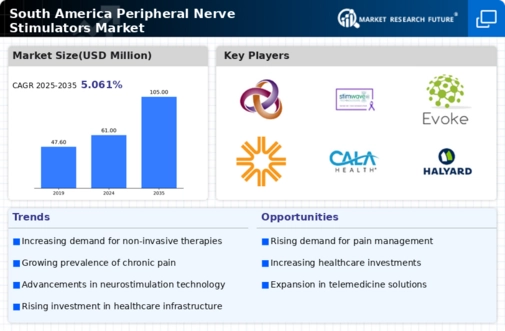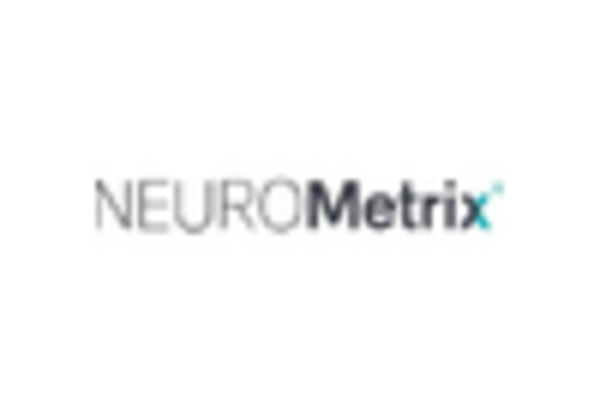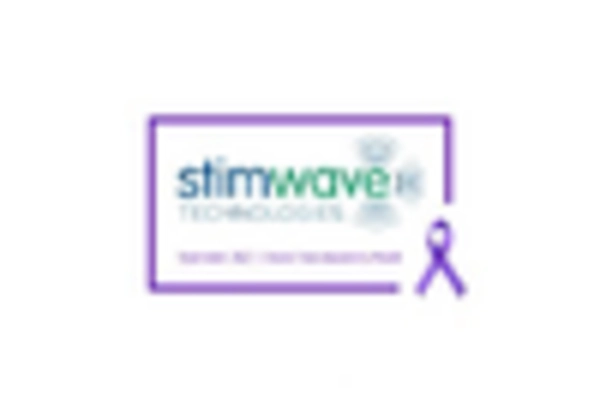Rising Healthcare Expenditure
Healthcare expenditure in South America has been on an upward trajectory, which positively influences the peripheral nerve-stimulators market. Governments and private sectors are increasingly investing in healthcare infrastructure and advanced medical technologies. For instance, healthcare spending in Brazil is projected to reach $200 billion by 2025, reflecting a commitment to improving patient care. This financial support enables the adoption of innovative treatments, including peripheral nerve stimulators, which are essential for managing chronic pain and neurological conditions. As healthcare budgets grow, the peripheral nerve-stimulators market is likely to benefit from enhanced accessibility and availability of these devices.
Supportive Regulatory Environment
The regulatory landscape in South America is becoming increasingly supportive of advanced medical technologies, including peripheral nerve stimulators. Regulatory bodies are streamlining approval processes for innovative devices, which facilitates quicker market entry. This supportive environment encourages manufacturers to invest in research and development, leading to the introduction of new and improved products. As a result, the peripheral nerve-stimulators market is likely to witness accelerated growth, as more devices become available to healthcare providers and patients. The proactive stance of regulatory agencies is essential for fostering innovation and ensuring that effective pain management solutions reach those in need.
Technological Innovations in Medical Devices
Technological advancements in medical devices are significantly impacting the peripheral nerve-stimulators market. Innovations such as miniaturization, wireless connectivity, and improved battery life are enhancing the functionality and user-friendliness of these devices. In South America, manufacturers are increasingly focusing on developing cutting-edge solutions that cater to the specific needs of patients. For example, the introduction of smart peripheral nerve stimulators that can be controlled via mobile applications is gaining traction. This trend indicates a shift towards more personalized and effective treatment options, thereby driving growth in the peripheral nerve-stimulators market.
Growing Awareness of Pain Management Solutions
There is a notable increase in awareness regarding pain management solutions among healthcare professionals and patients in South America. Educational initiatives and campaigns are emphasizing the importance of effective pain management strategies, which include the use of peripheral nerve stimulators. This heightened awareness is leading to a shift in treatment paradigms, where non-invasive options are being prioritized. As a result, the peripheral nerve-stimulators market is experiencing a surge in demand, as patients seek alternatives to traditional pain relief methods. The market is expected to grow as more individuals recognize the benefits of these advanced technologies.
Increasing Prevalence of Neurological Disorders
The rising incidence of neurological disorders in South America is a crucial driver for the peripheral nerve-stimulators market. Conditions such as neuropathic pain, multiple sclerosis, and Parkinson's disease are becoming more prevalent, leading to a growing demand for effective treatment options. According to health statistics, approximately 10% of the population in South America suffers from some form of neurological disorder, which is expected to increase. This trend necessitates innovative solutions, such as peripheral nerve stimulators, to manage symptoms and improve patients' quality of life. The peripheral nerve-stimulators market is thus positioned to expand significantly as healthcare providers seek advanced therapies to address these challenges.


















Leave a Comment